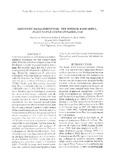Hatchery management for the window-pane shell, Placuna placenta Linnaeus, 1758
Share
Abstract
To relieve pressure on wild stock population, a hatchery technique for the window-pane shell, Placuna placenta Linnaeus has to be developed. A study was conducted to determine the suitable algal diet for P. placenta during gonad development and larval rearing. Sexually immature P. placenta broodstock were reared in the estuary or in tanks for four months. Tank-reared animals were fed daily mixture of Isochysis galbana (T-ISO) Parke and Tetraselmis tetrahele (G.S. West) at 100,000 cells/ml, 1:1 (100-I:T), or 200,000 cells/ml, 3:1 (200-3I:T) combinations. Monthly gonad histological examination showed that sexual maturity was attained by animals fed 200-3I:T diet after four months but not in 100-I:T. Estuary-reared broodstock had the highest gonad index among treatments after the first month, but did not reach sexual maturity until the end of the conditioning period. Sexually mature P. placenta from 200-3I:T fed-group spawned when exposed to UV light-irradiated seawater. One-day old larvae were reared in UV light-irradiated seawater until metamorphosis to plantigrade. Larvae were fed daily with monoalgal diet of I. galbana, T. tetrahele, or Chaetoceros calcitrans (Takano) at densities of 10,000-30,000 cells/ml. Larval settlement was observed in all diets after 14 days. Survival rate at metamorphosis was highest (12.60%) when diet of I. galbana was used, but lowest in T. tetrahele [5.1%) (P<0.05). Average shell length increment during the 14 days rearing period were 11.0, 11.38 and 9.92 µm day-1, for Isochrysis, Tetraselmis and Chaetoceros fed larvae, respectively.
Suggested Citation
Madrones-Ladja, J. A., & de la Peña, M. R. (2000). Hatchery management for the window-pane shell, Placuna placenta Linnaeus, 1758. In J. Hylleberg (Ed.), Proceedings of the 10th International Congress and Workshop of the Tropical Marine Mollusc Programme (TMMP), 20-30 October 1999 (Phuket Marine Biological Center Special Publication 21(1), pp. 189–194). Phuket, Thailand: Phuket Marine Biological Center.


